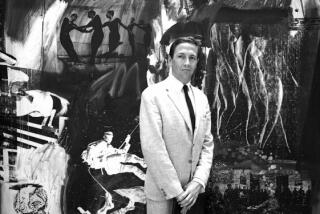COMMENTARY : ‘Degenerate Art’ Looks at Hitler’s Infamous Exhibition
If you’ve watched or listened to any of the broadcasts of the ongoing Senate hearings concerning lifting the ban against homosexuals serving in the U.S. military, you might also want to tune into KCET-TV Channel 28 Sunday at 10 p.m. to watch “Degenerate Art.” The one-hour special looks at Adolf Hitler’s infamous 1937 exhibition in Munich condemning modern painting and sculpture.
No, Sen. Sam Nunn (D-Ga.) and his crew in Washington are not closet neo-Nazis. But, modern prejudices against gays and lesbians do have their source in the same turn-of-the-century orthodoxy that lay the hideous groundwork for the Holocaust. “Degenerate Art” is a show about history, but it reverberates against crucial issues of the present too.
Los Angeles County Museum of Art curator Stephanie Barron served as executive producer of the special, together with five-time Emmy winner David Grubin, who also wrote and directed. The program is based on Barron’s widely acclaimed re-creation and analysis of Hitler’s notorious exhibition “Degenerate Art: The Fate of the Avant-Garde in Nazi Germany,” which was the highlight of LACMA’s 1991 season.
The museum show, which had been in the works since the mid-1980s, galvanized attention. Its opening had coincided with furious debates over government censorship in the United States, as politically motivated battles raged about the National Endowment for the Arts.
Given the show’s critical and popular success, two more venues were hastily added to its tour. After a planned stop in Chicago, it went on to sites in Washington and Berlin.
Among the program’s most interesting features is a series of interviews with visitors to the original 1937 exhibition, who returned to the Altes Museum for the LACMA show. Their eyewitness accounts are often riveting, as much for the poignant shadow of the nearly incomprehensible magnitude of the crushing events through which they lived as for the specific anecdotes they have to tell.
Josephine Knapp, an American art historian, was on a Rockefeller Foundation fellowship in Europe in 1937 and almost accidentally found herself in Munich. Titus Felixmuller is the son of artist Conrad Felixmuller, whose work was mocked and condemned along with paintings, sculptures and prints by Marc Chagall, Emil Nolde, Oskar Kokoschka, Max Beckmann, Ernst Kirchner and dozens more.
Karla Eckert had the odious task of promoting the exhibition in the official Nazi newspaper. German student Kurt Assis was sent to see the show when it traveled to Berlin.
Peter Guenther, a German expatriate and professor emeritus of art history at the University of Houston, saw it in Munich, where he also walked across the park to see Hitler’s concurrent exhibition of governmentally sanctioned German art. The stark disparity between the shows, one of reviled Modernists and the other of Hitler’s fondness for an art of treacle and bombast, would form the polarities of American critic Clement Greenberg’s enormously influential 1939 essay “Avant Garde and Kitsch.”
The second highlight of the program is its reckoning with Hitler himself--with his taste and canny understanding of cultural manipulation. The Austrian-born dictator had been a painter in his youth, which partially explains his subsequent vehemence with regard to the political uses of art and his appointment of Joseph Goebbels as cultural propagandist. His own failure to be successful as an artist heightened his resentment against German Modernists, whose work had been heartily accepted into state-funded museum collections.
In the numerous examples of his work that are shown, Hitler’s aesthetic sense turns out to be revealing. His paintings are bright, cheerful, starkly idealized images of the people and the land--of a cheerful peasant mother and her baby in a veiled masquerade as the Madonna and Child; or, a triumphant landscape, meant as a paean to the glories of the fatherland.
Hitler’s ostensibly “wholesome” paintings were made in conscious and committed opposition to prevailing notions in the years following the turn of the century. The idea of “the degenerate,” as a general term of opprobrium, was then ubiquitous; Hitler’s clinically scrubbed art meant to represent a countervailing ideal.
The concept of degeneracy was a central principle of medical, biological and anthropological science, which had developed in the 19th Century. Hitler appropriated the idea as a primary, all-purpose symbol to describe enemies of the National Socialist ideal.
The Nazi eradication of what was claimed to be degenerate in the symbolic realm of the visual, literary and performing arts was, quite logically, an early warning signal of a philosophy that would soon be applied to selective groups of human beings. Like the paintings that were rounded up and the books that Hitler burned, ostensibly degenerate people were soon dealt with in a final solution.
Although the PBS special might seem a bit rudimentary to those who fully engaged the LACMA exhibition, it is thorough and often moving as an introduction to the events of 1937. It’s also a potent and timely reminder that those events have latent consequences, which linger to this day.
For example: Sen. Robert Dole (R.-Kan.) was asked on CBS Wednesday night why he opposed lifting the ban on gays in the military. He said he was of course opposed to discrimination, but he also regarded homosexuality to be a physical disability, not unlike the one that had incapacitated his own right arm.
The now thoroughly discredited, Victorian-era fabrication of homosexuality as a medical pathology was among the host of examples of so-called degeneracy that had once festered in the mind of a twisted Austrian painter. In the halls of the U.S. Senate, the old demagogic lie had casually reared its ugly head once more.
More to Read
The biggest entertainment stories
Get our big stories about Hollywood, film, television, music, arts, culture and more right in your inbox as soon as they publish.
You may occasionally receive promotional content from the Los Angeles Times.







